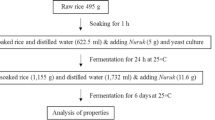Abstract
Random amplified polymorphic DNA (RAPD) analysis was employed to characterize commercial winery yeast strains currently used in Brazilian industries and to examine the relationship between them. Sixteen strains were subjected to RAPD analysis using eight primers, selected from the 40 primers of the kits B and X of Operon Techn. From the total of 93 scorable bands, 39 (41.9%) were polymorphics. Using the accumulated information of several reactions, all strains under investigation were differentiated. Cluster analysis revealed three groups. Most of the strains (11) were clustered in one group. The highest distance (28%) was obtained with the strain Redstar (Universal Food Corp.).
Similar content being viewed by others
References
Barros Lopes, M., Soden, A., Henschle, P.A. & Landridge, P. 1996 PCR differentiation of commercial yeast strains using intron splice site primers. Applied and Environmental Microbiology 62, 4514-4520.
Blodin, B. & Vezinhet, F. 1988 Identification de souches de levures oenologiques parleurs caryotypes obtenus en électrophorése en champ pulsé. Revue Française de Oenologie 28, 7-11.
Clark, A.G. & Lanignan, M.S. 1993 Prospects for estimating nucleotide divergence with RAPDs. Molecular Biology and Evolution 10, 1096-1111.
Degrée, R., Thomas, D.Y., Ash, J., Mailhiot, K., Morin, A. & Dubor,C. 1989 Wine yeasts strain identification. American Journal of Enology and Viticulture 40, 309-315.
Echeverrigaray, S., Tavares, F.C.A., Lavi, U., Gal, O. & Hillel, J. 1995 Minisatellite probes in yeast DNA fingerprinting. Revista Brasileira de Microbiologia 25, 207-209.
Guthrie, C. & Fink, G.R. 1991 Guide to Yeast Genetics and Molecular Biology. San Diego, CA: Academic Press, ISBN 0-12-310670-2.
Heard, G.M. & Fleet, G.H. 1986 Occurrence and growth of yeast species during the fermentation of some Australian wines. Food Technology Australia 38, 22-25.
Huffman, J.L., Craneguy, B., Zucca, J. & Poulard, A. 1992. Authentication of ATCC strains in the Saccharomyces cerevisiae complex by PCR fingerprinting. Experimental Mycology 16, 316-319.
Lavallée, F., Salvas, Y., Lamy, S., Thomas, D.Y., Degrée, R. & Dulau, L. 1994 PCR and DNA fingerprinting used as a quality control in the production of wine yeast strains. American Journal of Enology and Viticulture 45, 86-91.
Lodder, J. 1970 The Yeasts. A Taxonomic Study. Amsterdam: Elsevier/ North-Holland Publishing ISBN 0-7204-4054-8.
MacPherson, J.M., Eckstein, P.E., Scoles, G.J. & Gajadahar, A.A. 1993 Variability of random amplified polymorphic DNA assay among thermal cyclers, and effects of primer and DNA concentration. Molecular and Cellular Probes 7, 293-299.
Meaden, P. 1990 DNA fingerprinting of brewers' yeast: current perspectives. Journal of the Institute of Brewing 96, 195-200.
Nadal, D., Colomber, B. & Piña, B. 1996 Molecular polymorphism distribution in phenotypically distinct populations of wine yeast strains. Applied and Environmental Microbiology 62, 1944-1950.
Polaina, J. & Adams, A.C. 1991 A fast procedure for yeast DNA purification. Nucleic Acids Research 19, 5443.
Querol, A., Barrio, E., Huerta, T. & Ramón, D. 1992 Molecular monitoring of wine fermentations conducted by active dry yeast strains. Applied and Environmental Microbiology 58, 2948-2953.
Quesada, M.P. & Cenis, J.L. 1995 Use of random amplified polymorphic DNA (RAPD-PCR) in the characterization of wine yeasts. American Journal of Enology and Viticulture 46, 204-208.
Rankine, B.C. 1968 The importance of yeasts in determining the composition and quality of wines. Vitis 7, 22-49.
Rohlf, F.J. 1992 NTSYS-PC: Numerical Taxonomy and Multivariate Analysis System. New York: Exeter Softeware.
Sambrook, J., Fritch, E.F. & Maniatis, T. 1989 Molecular Cloning: Laboratory Manual. 2nd Edition, Cold Spring Harbor, NY: Cold Spring Harbor Laboratory. ISBN 0-87969-309-6.
Schütz, M. & Garner, J. 1993 Analysis of yeast diversity during spontaneous and induced alcoholic fermentation. Journal of Applied Bacteriology 75, 551-558.
Swofford, D.L., Olsen, G.J., Waddell, P.J. & Hillis, D.M. 1996 Phylogenetic inference. In Molecular Systematics, eds. Hillis, D.M., Moritz, C. & Mable, B.K., pp. 407-514. Massachussetts: Sinauer Ass. ISBN 0-87893-282-8.
Versavaud, A., Courcoux, P., Roulland, C., Dulau, L. & Hallet, J.N. 1995 Genetic diversity and geographical distribution of wild Saccharomyces cerevisiae strains from the wine-producing are of Carentes, France. Applied and Environmental Microbiology 61, 3521-3529.
Vezinhet, F., Blondin, B. & Hallet, J.N. 1990 Chromosomal DNA patterns and mitochondrial DNA polymorphism as tools for identification of enological strains of Saccharomyces cerevisiae. Applied and Environmental Microbiology 32, 568-571.
Author information
Authors and Affiliations
Rights and permissions
About this article
Cite this article
Echeverrigaray, S., Paese-Toresan, S. & Carrau, J. RAPD marker polymorphism among commercial winery yeast strains. World Journal of Microbiology and Biotechnology 16, 143–146 (2000). https://doi.org/10.1023/A:1008993129713
Issue Date:
DOI: https://doi.org/10.1023/A:1008993129713




